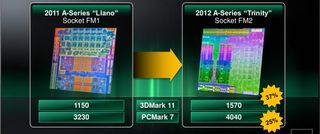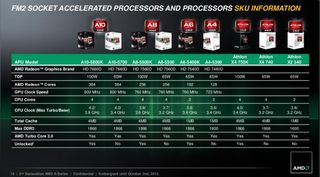AMD updates desktop APUs with Trinity

AMD has released more details about its upcoming Trinity desktop APUs today, showing off a bit more information about how the new Piledriver cores work and their estimated performance. Today's announcement excludes the desktop FX line, but gives us more of an idea of how competitive they'll be against Intel's Ivy Bridge.
Trinity was launched for laptops earlier in the year, so today's announcement is about updating the rest of the APU line to the new architecture.
The Trinty line up combines either one or two Piledriver cores (which means two or four x86 integer execution cores) in the A10, A8, A6 and A4 ranges of processors that are listed there in decreasing order of power. The CPU part of the chip is still Piledriver and not the recently revealed Steamroller architecture that will take over next year, but it's still a decent looking upgrade on earlier Llano chips.
The graphics part, meanwhile, has been redesigned to include parts of the HD7000 desktop board technology along with HD6000-series pipelines. It's still not Graphics Core Next , but I've been impressed in the past at the results possible from pairing a last gen A10 desktop chip with a low end graphics card for a budget Crossfire rig too – for about £120 you can get reasonable mid-range framerates for a second PC.
According to Tom's Hardware , one of the few sites that's had review samples of the A10 already – they make it around 10-20% faster than the outgoing Llano APU in a best case scenario and silly numbers better than a Core i3 at 1920x1080. While that sounds impressive, it's still not enough without a second GPU for fluid gaming in most newer games - although I'm itching to run some Black Mesa benchmarks on it personally.

The thing that intrigues me more than anything, however, is that AMD has re-introduced a very old fashioned idea with Trinity, that of the RAM disk. For those who are younger than – say – 35, a RAM disk is a virtual hard drive which takes a portion of your system memory and makes it appear in Windows Explorer as a new hard drive. We used to use them back when PCs were young and running games off a 5.4inch floppy was tough, but they've been of fairly niche interest for high performance computing since then. The advantages are that its theoretically faster than the best SSDs, and given the price of RAM it makes sense to set one up. Obviously, though, a RAM disk is stored on volatile memory so is lost when you power down and has to either be restored from a temporary image on boot or it starts fresh.
In other words, it's not a space you'd use to install games into, but as a cache it could be a smart rival for Intel's SRT. We should be able to test this out in time for the APU's on sale date, which AMD says is next week.
The biggest gaming news, reviews and hardware deals
Keep up to date with the most important stories and the best deals, as picked by the PC Gamer team.
Most Popular





